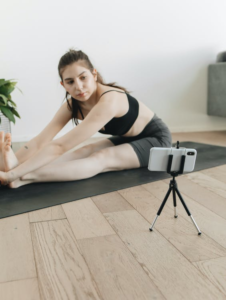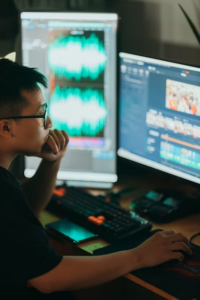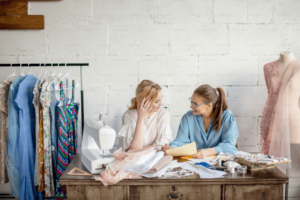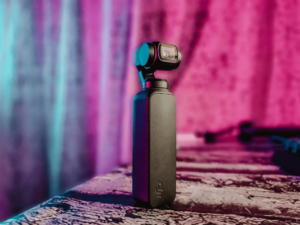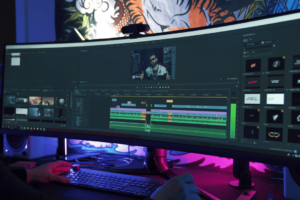A two shot is a shot that shows two subjects in the same frame. The subjects don’t necessarily have to be next to each other, sometimes a subject is in the foreground and the other is in the background. With the two shot, the director can choose between close-up shots, medium shots, long shots, and everything in between.
Origin of the Two Shot
The two shot first originated on television as an inexpensive way of getting both subjects inside of the frame without having to shoot more than one setup. Once it grew in popularity, the film industry began to use it. As filmmakers got more creative with their types of shots, they began to play around with the two shot. Now you can see it in many variations, as any shot with just two subjects in it is considered a two shot.
The Purpose of a Two Shot
Filmmakers use the two shot to show the emotions and reactions of two people in a scene, and they can play around with what the two shot conveys. Overall, the meaning behind the two shot heavily depends on the dynamic of the two subjects and the context surrounding this kind of framing, Let’s explore different ways directors use it:
Showcasing Romantic Relationships
It’s a great way to show a budding romance throughout a scene. For example, if one character is professing their love for another character, the two shot can show the audience the non-speaking character’s reaction as the other speaks. If you were to use a shot where you only see the love, you might feel a sense of suspense, whereas the two-shot framing helps you understand the romance during the dialogue.
Highlighting Intimate Actions
It’s also useful when showing an action happening between two characters. Whether that be a romantic scene where they kiss or an intense scene where they fight. If you were to see the same actions in a wide shot that includes other subjects, this could lose the intimacy between the two characters.
Comparing and Contrasting Characters
If two characters react differently, you can see they may be at odds with one another. You see this in “500 Days of Summer” right before the bar fight scene. At this point in the film, Summer feels distant from Tom. In a two shot, Summer seems stoic and cold while Tom leans into her, not realizing anything is wrong.
Visualizing How Characters Grow Apart
Likewise, if the two subjects are far apart in a two shot, this could indicate that their relationship is distant or that they feel uncomfortable around each other. The story may begin with the characters being close and touching, and then you see them getting farther apart throughout the film. The director may choose to frame the characters in a close-up two shot to begin with and then switch to a long shot as the relationship deteriorates.
Revealing information
Filmmakers can use the two shot to play with information revealed in a scene. For example, if two characters in a horror film look shocked and scared, you know they are both seeing something really scary.
Examples of the Two Shot
You can see the two shot in many films and television shows throughout classic and modern media. These specific examples can give you a better idea of how directors use the two shot to establish character relationships and move the story along:
Silverado
If you have seen a Western film, you likely have seen a two shot where two cowboys stand far apart while facing each other. This is evident in the classic film, “Silverado” during the final shootout scene. The two shot establishes tension as you wait for each cowboy to draw his gun. There is also a third bystander character that you get to see in multiple three shots. By switching between two shots, three shots, and single-subject shots, the audience gets to see each character’s reactions and relationships toward each other.
Pulp Fiction
You may also see the two shot when two characters are eating at a restaurant. There are countless films where the frame captures two characters sitting face-to-face in a diner booth. For example, in the film “Pulp Fiction,” many of the scenes take place in a diner location. Throughout the film, director Quentin Tarantino uses the two shot to establish different emotions, such as an energetic romance and high tension. Tarantino plays around with the framing and angles of these two shot scenes to establish completely different meanings.
La La Land
Another popular two shot is called a “two shot west” where the characters are facing forward, toward the audience. This type of scene is quite common if two characters are at the theater. It creates the illusion of how you would actually talk to someone else as you watch a film or a play. You see this shot in the film “La La Land” during the movie date scene where Mia and Sebastian begin to fall in love. Both actors are facing the screen, but the audience gets to see each subject stealing quick glances and smiles at each other.
Dead to Me
The two shot west is also quite common in driving scenes where the camera is in front of the car or on the hood, facing the actors. In the Netflix show, “Dead to Me,” there are countless scenes where two characters are in the car. We often get to see Jen and Judy’s separate reactions to an event at the same time. The two shot helps the filmmaker juxtapose these two very different characters.
Three Shot: Definition
Like the two shot, the three shot tells you how many characters are in the frame at once, in this case, three. The three shot is quite popular in television shows and films where there are three main characters. For example, in the “Harry Potter” franchise, you often see shots with Harry, Hermione, and Ron all in the same shot. Since Harry is the protagonist, you often see him in the foreground of the shot.
Another movie that loves to use the three shot is “Ferris Bueller’s Day Off.” When Ferris, Cameron, and Sloane are all in Cameron’s dad’s car, you see Ferris and Sloane looking relaxed and happy while Cameron is anxious in the back seat. This is a great way to show all three of these characters’ attitudes and behaviors alongside one another.
Four Shot: Definition
Considering a two shot has two subjects and a three shot has three subjects, then you can guess that a four shot has four subjects. Though this may create a busier scene, it is quite easy to get four subjects in a frame if you do a medium or long shot. You see this shot in the original “Ghost Busters,” when all four characters react to the giant marshmallow man. You can see all of them working together to come up with a plan and destroy the monster.
It’s also a way to create separate identities for multiple central subjects. You see this in the television show and movie franchise, “Sex and the City.” All four main characters often walk alongside each other on the streets of New York City. This shot is a way for the director to show each character’s unique sense of style and attitude. It also shows that these women are very connected and travel in a pack.
You can see the two-shot technique across many movie genres since it is a versatile framing option. Learn more about these framing options and more by enrolling in our Cinema Production program.
